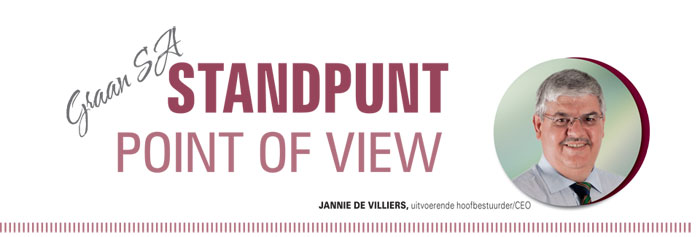March 2014

JANNIE DE VILLIERS, uitvoerende hoofbestuurder/CEO
The other day Braam Olivier shared the apt concept of the blinkblaar wag-‘n-bietjie tree (called the common hook thorn in English) with us at the grain value chain’s annual planning meeting. He explained that one sometimes walks in the bush, enjoying it so much that you do not keep an eye out for what is happening around you. Then suddenly a wag-‘n-bietjie tree “grabs” you, just to bring you back to your senses.
You then have to stop, take note of your surroundings and take time to pull out the thorns, then look ahead and again set course to forge ahead. That set me thinking on how we as a grain industry these past 17 years just moved ahead in the free market “bush”. Initially we had to adjust, make new plans and put structures in place to assist us in getting though this “bush”.
The wag-‘n-bietjie moment for the grain industry, however, happened last year when the Minister of Agriculture, Forestry and Fisheries announced recommended amendments to the marketing act. She definitely took the forestry thing seriously and is now busy eradicating the free market “bush” roots and all.
There are as yet very few indications of what she intends to replace it with; save that she will be the one making the decisions in future. Those of us who knew the old controlled marketing system, will surely have a shiver or two up our spines thinking back to a system where the minister made all the decisions. If one had a minister who was sympathetic towards agriculture, it might still have worked, but my goodness, the way it looks now, producers are definitely going to come second. Grain SA will obviously have to give serious consideration to what this wag-‘n-bietjie moment holds for us as producers. Every thorn will have to be removed carefully and the wounds dressed (maybe even mend some clothes); then we must look up and find a way forward.
There are two serious thorns I would like to point out today: Firstly the onslaught to replace the free market system with a control system and secondly, the efforts of the minister to gain control over the funds in the grain trusts.
The free market showed its mettle over the past 17 years. There has been enough food in the country each year. At times it was expensive due to world supply conditions, but for the same reasons there were times when grain was cheap. Never a shortage!
The trusts initially started off with the dream of making additional funds available for things such as research and to help with the development of our new entrants into the grain industry. Very quickly it became clear to us that the funds rather had to be utilised where the capacity shortages of government had to be augmented.
There were no funds for market information, government funding for research had almost dried up and no contributions were made towards the development of our new entrants. I can hardly imagine how the industry will be without the support of the trusts. No SAGIS, SAGL, agricultural development programme, research and wheat breeding, not even mentioning the millions of rands we have contributed to capacity building in the ARC.
Imported wheat is tested only haphazardly by the state and the results are not published to ensure transparency. If the SAGL does not do testing with the help of trust funds, we will not even know what we are eating.
Last year with great excitement, we experienced a change when the Department of Rural Development and Land Reform made available large sums of money to capitalise our developing farmers. The auditor general came to audit the Grain SA book keeping and was full of praise for the thoroughness and accuracy with which we handled it.
Producers were equipped with tractors, planters, ploughs and spraying equipment. It was therefore with great expectation that we submitted a new request for funding in July 2013 to further assist the men and women for another year to turn them into commercial farmers.
Eventually in December 2013 we got the answer that it was too late and that we should rather start planning for the next year. I wonder if the funds were suddenly required to cover other priorities (read elections) rather than food production. One can only think how the producers must feel who now have implements, but do not have access to funding to buy crop inputs. What a disappointment!
Publication: March 2014
Section: Editorial